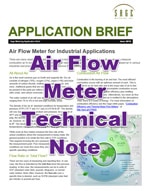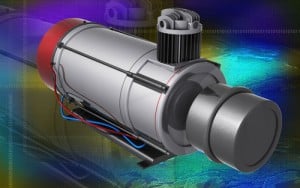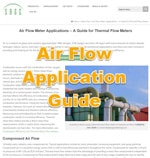Manufacturers using compressed air and compressor manufacturers and distributors use thermal mass flow meters in seven different applications. The meter assists in:
-
- Situation audits
- Facilities monitoring
- Submetering/billing
- Energy conservation
- Leak detection
- Compressor optimization
- Compressor performance testing
Industrial Compressed Air

Thermal mass flow meters can assist compressor manufacturers, compressor distributors, and manufacturers in using compressed air in different ways.
Facilities Monitoring and Submetering and Billing
Thermal mass flow meters can monitor compressed air usage rates among various facility departments to help allocate expenses, track overall usage, and improve plant efficiency. Thermal mass flow meters can provide both the total consumption and permit monitoring of the time to help identify periods of high consumption.

Leak Detection
Because compressed air is expensive, compressed air leaks are costly if they are left unchecked. For example, if a compressor running at 100 PSI (approximately 6.6 bar) had only one ¼” leak, there would be over 104 FT3/minute compressed air wasted. If that facility ran 24 hours/day at the cost of $0.32/kWh, the annual cost of that wasted energy would exceed $17,000. (1)
By placing thermal mass flow meters and isolation compression fittings at multiple points in the air distribution system, one can monitor for leaks. The Sage thermal mass flow meter’s extreme low-range sensitivity detects the very low flow rates during system startup and commissioning. The equipment using compressed air is powered down and sealed off (isolated) to detect leaks, then the lines are pressurized. In this case, any flow in the pipe system would originate from a leak.
For more information on thermal mass flow meters to quantify compressed air leaks, visit Compressed Air Flow Monitoring.
Compressor Optimization and Situation Audits
Many compressor manufacturers use thermal mass flow meters in the design, testing, installation, and operation of their compressors to ensure their equipment’s most efficient operation. Additionally, compressor distributors use thermal mass flow meters to conduct audits in large plants to assess compressor efficiency and locate leaks.
When purchasing a new compressor, a thermal mass flow meter may provide the user with a baseline for current compressed air usage.
Compressor Performance Testing
Many large building automation contractors do performance testing on behalf of their large customers. These contractors routinely use thermal mass flow meters to measure compressed air, natural gas, nitrogen, and other common gases; they also frequently recommend that their customers install the meters after the audit to monitor the gases permanently.
In part three of this series, we address Five Thermal Mass Flow Meter Applications on Natural Gas.

(1) The total cost of 100 psig compressed air is in the general range of 18 to 32 cents per 1,000 cubic feet. (Best Practices for Compressed Air Systems by Compressed Air Challenge. www.compressedairchallenge.org)
Image by Mohamed Hassan from Pixabay

